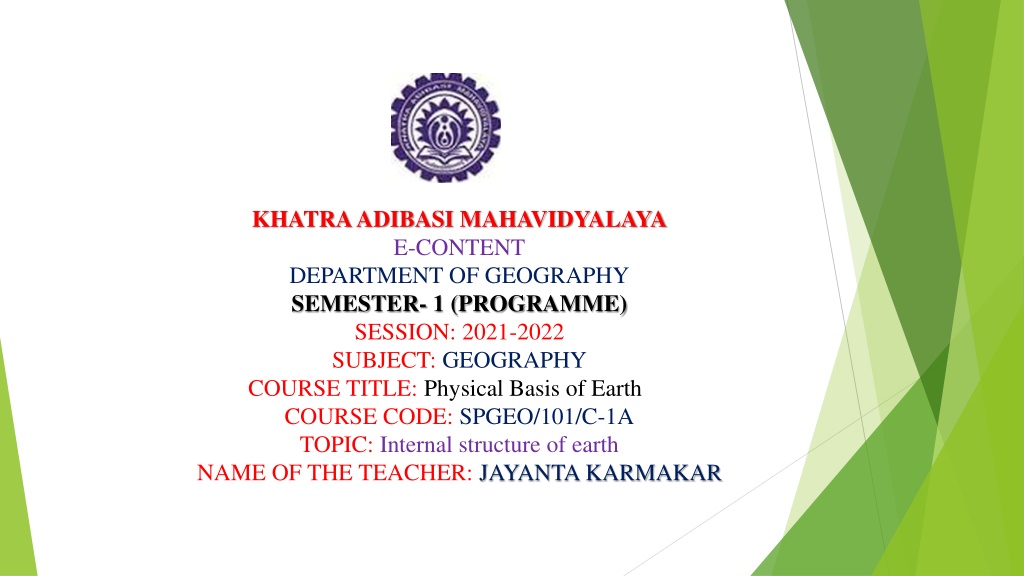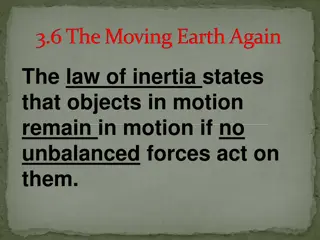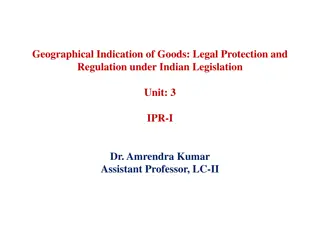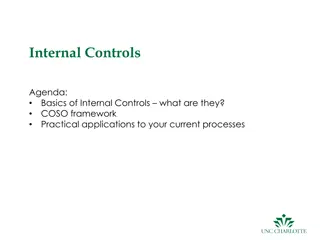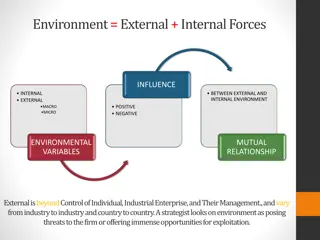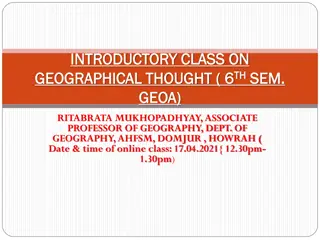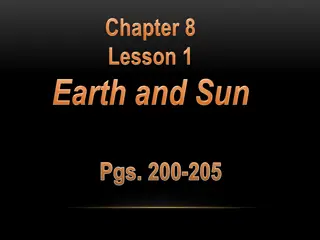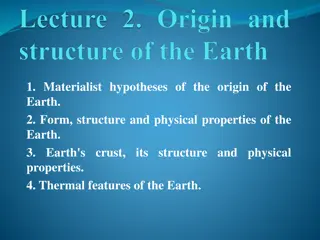Understanding Earth's Internal Structure: A Geographical Perspective
Deep parts of Earth's interior are studied indirectly through geophysics, including seismic waves, magnetic fields, gravity, and heat. Seismic studies reveal Earth's layers - crust, mantle, and core - each with distinct properties and compositions. The lithosphere, comprising the upper mantle and crust, interacts with the asthenosphere, allowing for plate movements. The Moho boundary separates the crust from the mantle, indicating a significant change in composition. The properties of continental and oceanic crusts differ in terms of thickness, density, and composition, providing insights into the Earth's dynamic structure.
Download Presentation

Please find below an Image/Link to download the presentation.
The content on the website is provided AS IS for your information and personal use only. It may not be sold, licensed, or shared on other websites without obtaining consent from the author. Download presentation by click this link. If you encounter any issues during the download, it is possible that the publisher has removed the file from their server.
E N D
Presentation Transcript
KHATRA ADIBASI MAHAVIDYALAYA E-CONTENT DEPARTMENT OF GEOGRAPHY SEMESTER- 1 (PROGRAMME) SESSION: 2021-2022 SUBJECT: GEOGRAPHY COURSE TITLE: Physical Basis of Earth COURSE CODE: SPGEO/101/C-1A TOPIC: Internal structure of earth NAME OF THE TEACHER: JAYANTA KARMAKAR
Internal structure of earth OUTER CORE MANTLE INNER CORE CRUST A Schematic view of interior of earth
Introduction Deep parts of Earth are studied indirectly, however, largely through the branch of geology called geophysics. Geophysics includes the study of seismic waves and Earth s magnetic field, gravity, and heat. Together, they create a convincing picture of what makes up Earth s interior. There are two important ways of learning about Earth s interior. 1.seismic reflection 2.Seismic refraction
By seismic study earth has following layers: 1-The crust Continental crust Oceanic crust 2-The mantle Upper mantle Lower mantle 3-The core Outer core Inner core
The uppermost layer of earth is called crust. Studies of seismic waves have shown that the crust is thinner beneath the oceans as compare to the continents. On this basis crust is divided into two types. Continental crust Oceanic crust Seismic waves travel faster in oceanic crust than in continental crust. Seismic P waves travel through oceanic crust at about 7km/s & about 6km/s through continental crust.
Lithosphere The combination of uppermost mantle and crust above the asthenosphere is called the lithosphere. The lithosphere is free to move over the weak asthenosphere. The tectonic plates are, in. fact, lithospheric plate Moho Boundary: The boundary that separates the crust from the mantle is called the Mohorovic ic discontinuity.
Properties of the Crust: Continental Crust: Composition: felsic, intermediate, and mafic igneous, sedimentary, and metamorphic rocks. Age: 0 to 4 B.y. Summary: thicker, less dense, heterogeneous, Oceanic Crust: Depth to Composition: mafic igneous rock (basalt & gabbro) with thin layer of sediments on top Age: 0 to 200 M.y. Summary: thin, more dense, homogeneous, Depth 20 to 70 km, average 30 to 40 km Moho: ~7 km
The Mantle: The next layer below the crust is mantle. Its thickness extended to a depth of 2890km. It is more denser than crust It consist of dense silicate rocks both p-waves & s-waves travel through the mantle depths of around 100 km to 250 km arrive later than expected (because pressure is increasing) indicating a zone of low seismic wave velocity.
Velocity of seismic waves in mantle: P-waves velocity: Its velocity is about 8km/s in the upper mantle and increases up to 13km/s in lower mantle S-waves velocity: S-waves velocity profile in the mantle is similar to the p-wave profile. S-waves velocity time cannot be measured as accurately as p- waves travel time.
The core The central or innermost portion of earth below the mantle is core it lies at depth of 2900km up to 6370km the core is divided into two layers outer core inner core Outer core: The outer core begins at a depth of 2,890 to 5,150 km. The temperature at outer core is about 3700 C Inner core: The inner section begins at a depth of 5,150 to 6,360km. The temperature of inner core is about 4300 C.
Evidence of Liquid Outer core: Seismologists first determined that the back and-forth motion of S-waves does not travel through liquid. Then, seismologists noticed that S-waves do not travel through Earth s center. This observation led to the discovery that Earth s core must be at least partly liquid.
